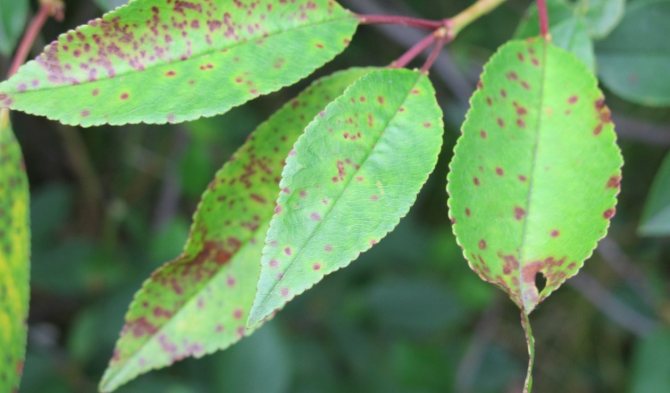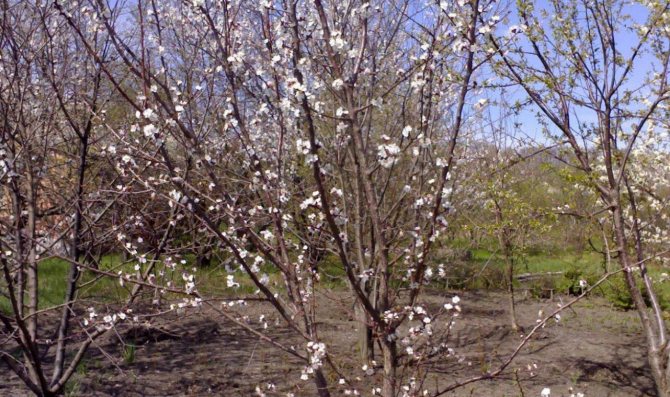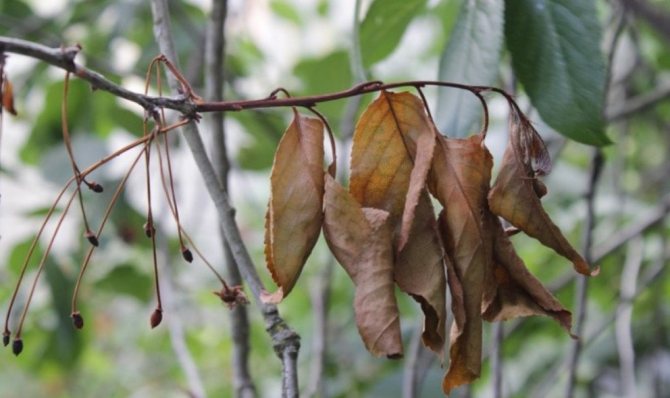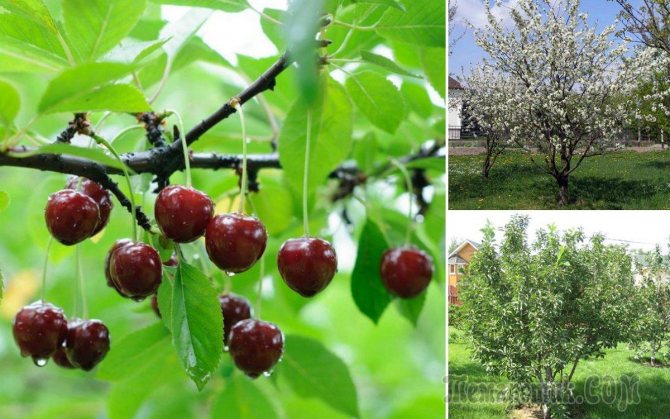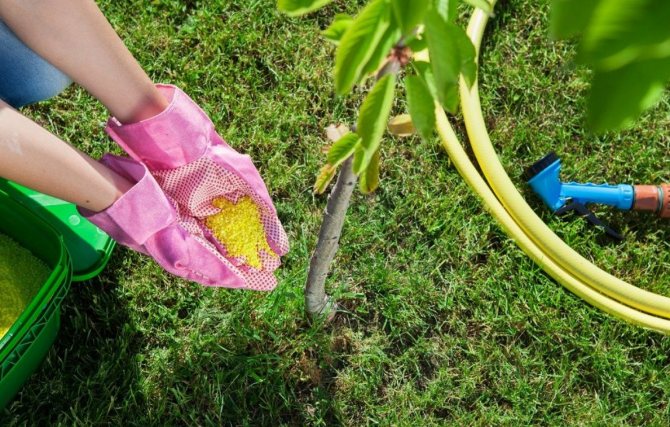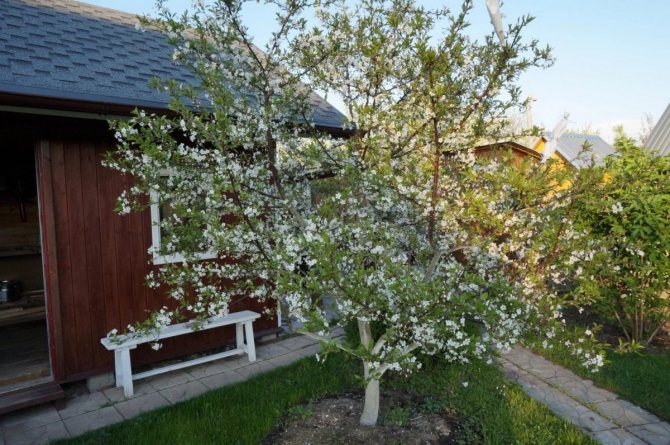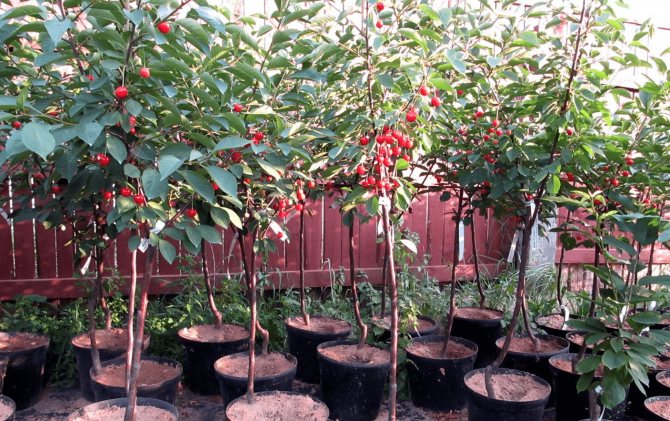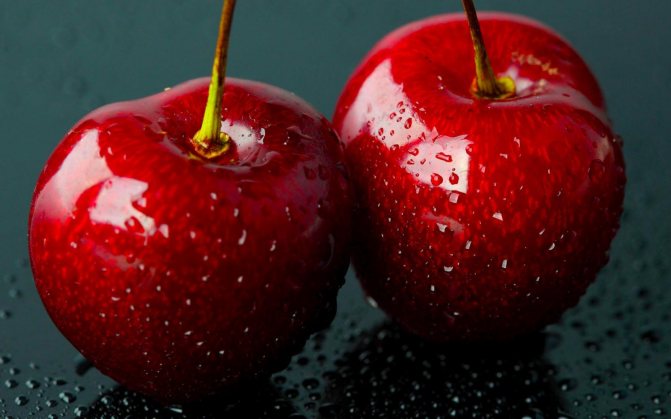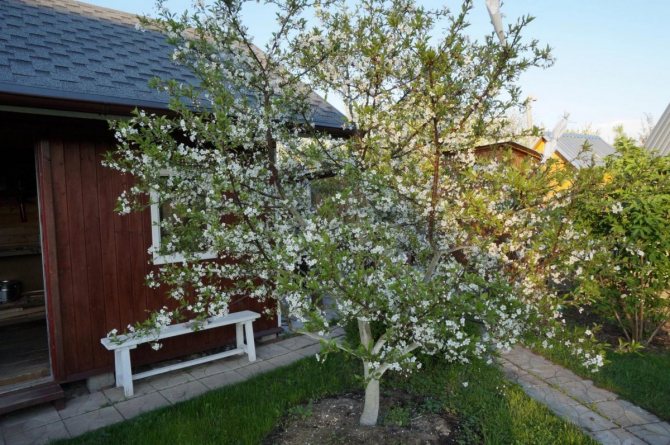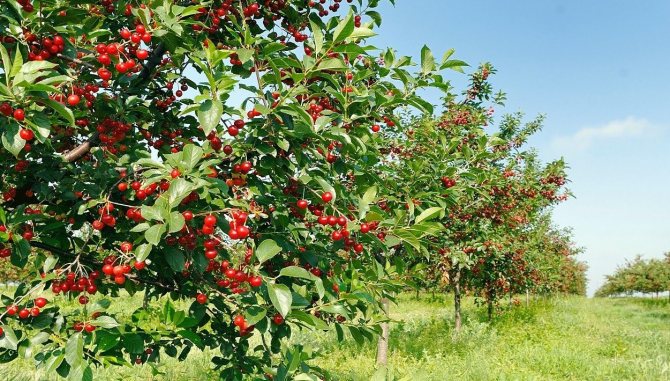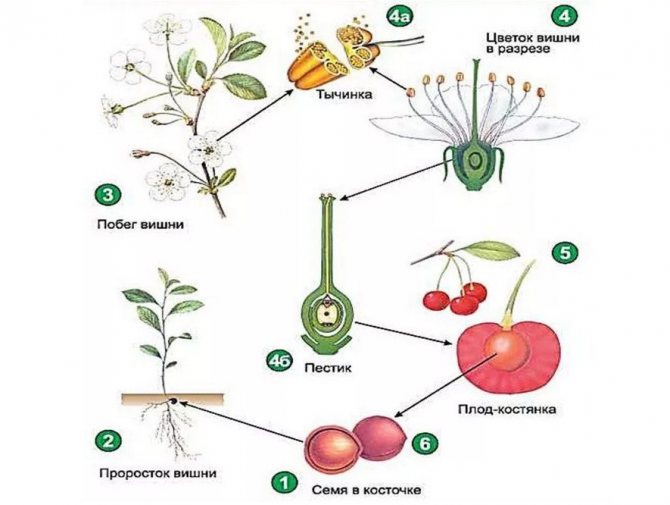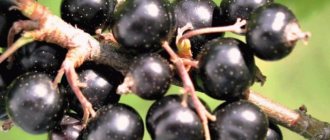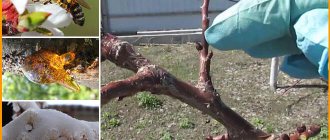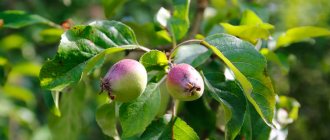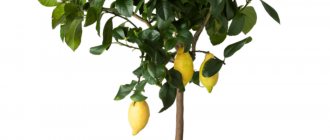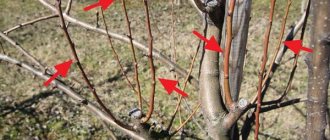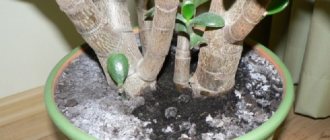If the cherry is not fruitful, gardeners prefer to cut down the planting and free up space, rather than figuring out the reasons for the failure. For good fruiting of cherries, special conditions are not required, the culture is quite unpretentious, but it also has its own characteristics.

Growing cherries. Illustration for this article is used under a standard license <113
Deepening of the root collar during planting
Usually, the growth retardation of a popular garden tree is the result of improper planting. Remember, the root collar should be two to three centimeters above the soil. Its deepening sometimes ends in the death of the planting material. Novice gardeners often confuse the root collar with the grafting site. The first is located below, where the roots merge into the trunk.
If the fact of such a reason is established, the situation is easily corrected. For this, the earth is raked off the trunk. As a rule, trees bear fruit in the next season, in the worst case in the second year.
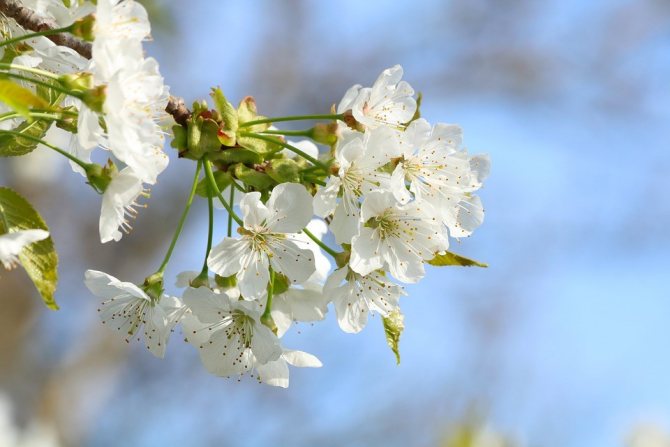

Care features
Its further growth and fruiting depends on the correct planting site of the tree. The average age of the culture is approximately 15-30 years, but this depends on the care.
It is better to plant cherries in early spring in a prearranged place. It is possible in the fall, but then the risk increases that the tree will not have time to take up after planting and will freeze from the extreme cold.
It is worth choosing a planting hole for a cutting carefully. Sandy loam soils with low acidity without nearby groundwater are best suited. You need to dig a hole, the depth of which is 50 cm, the width is 60 cm.
Pour a mixture of ordinary earth with humus at the bottom and add 20 g of superphosphate, 1 kg of wood ash and 25 g of potassium. You can also use a bucket of forest sand.
Gently immerse the root of the plant in the soil, then sprinkle with dry earth on top, water. You can dig a groove around so that when watering, the water does not spread, but falls right under the root. The distance between the planted trees must be at least 2.5 m.
After planting, do not stop leaving. It is necessary to constantly loosen the ground, fertilize, cut off unnecessary branches, spray from parasites and diseases.
The plant calmly reacts to drought, but if it is watered, then the fruits will be many times larger and they will become larger and juicier. You need to act depending on the total moisture content of the soil, air, amount of precipitation. It is imperative to water the cherries when they begin to bloom, while pouring the berries and before the dormant period begins. In late autumn, it is worth loosening the soil around the trunk deeper and adding mineral fertilizers there. It can be nitroammophoska, urea, humus, cow dung, superphosphate, dry potassium. Saltpeter is best given in early spring, when the tree is just waking up.
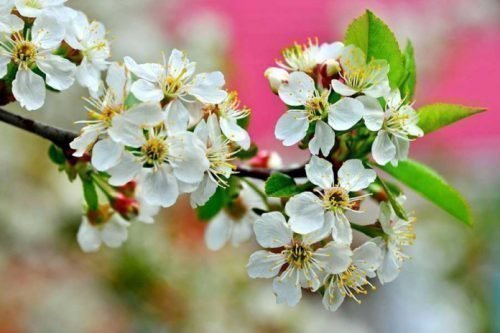

Lack of pollination
A common reason for the lack of berries is the lack of pollination. The lion's share of cherry varieties require pollinating varieties that bloom at the same time as growing trees. If the flowers continue to be pollinated with their own pollen or pollen from cherries of the same variety, the tree will yield no more than 5% of the possible yield.
In order for the trees to be fully pollinated, it is not necessary to plant different varieties in one place. The main thing is that the cherries grow no further than 30 meters from each other.
If there is no place on the site for planting new varieties, experienced gardeners graft a couple of cuttings of other varieties into the cherry crown, but with the same flowering period. Cuttings are grafted at a height, otherwise pollen will not get on many flowers. It will be possible to get a full harvest only after strong shoots develop from the grafted cuttings.
You can increase yields by attracting bees and other insects - planting flowers in near-stem circles and sprinkling trees with sweet water (honey + sugar).


Preventive measures
Among the preventive measures that can ensure timely fruiting of cherries, the following are distinguished:
- Choose the optimal place for planting and determine the acidity of the soil in it using litmus paper. If the acidity is high, then make a preliminary introduction of dolomite flour or lime.
- Add organic matter and phosphorus-potassium fertilizers to the planting pit. Do root and foliar dressing on time.
- To stimulate the formation of ovaries, spraying with boric acid twice (before and during flowering). To do this, dissolve 1 bottle of the product in a bucket of water. After flowering, you should use fruit-forming stimulants of the "Universal Ovary" type. These treatments are especially relevant in adverse weather conditions (rain or heat).
- For self-fertile varieties, it is imperative to plant another variety of cherries next to it. If there is not enough space, choose self-fertile trees. If spring frosts are frequent, then you should stop at late-flowering cherries.
- Attract insects - plant melliferous plants blooming in May next to cherries, make sweet baits and sprinkle with sugar solution (1 tablespoon for 1 glass of water).
- In spring return frosts, smoke bombs must be used, to increase the temperature and prevent icing of the flower buds.
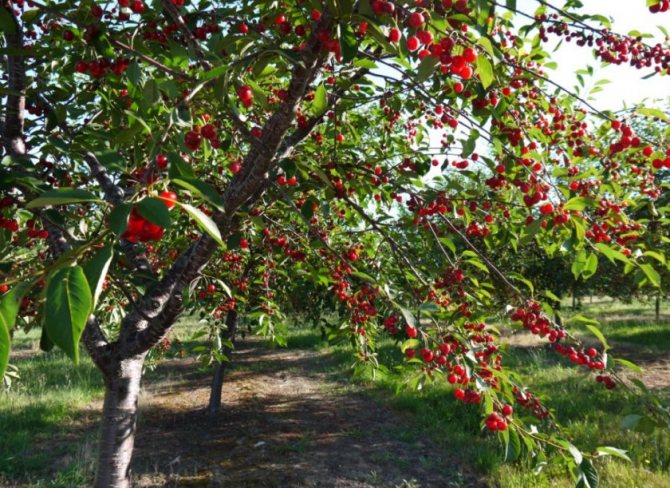

Invasion of insect pests and the appearance of various diseases can significantly reduce the yield of any fruit tree.
Therefore, gardeners recommend taking preventive measures to prevent their appearance:
- conduct regular inspection and remove branches affected by the disease;
- remove and burn fallen fruits and foliage;
- cover the places of cuts, wounds and cracks with garden pitch to avoid infection;
- carry out measures to protect against rodents;
- do processing in the spring and autumn of the trunks with slaked lime;
- dig up the soil and process it with a urea solution;
- to strengthen the immune system of the tree, carry out the recommended fertilizing.
It is imperative to carry out preventive spraying with fungicidal agents at least three times per season to protect against the appearance of fungal and infectious diseases:
- the first spraying is carried out in early spring before bud break;
- the second - after abundant flowering;
- the third - 30 days before harvesting.
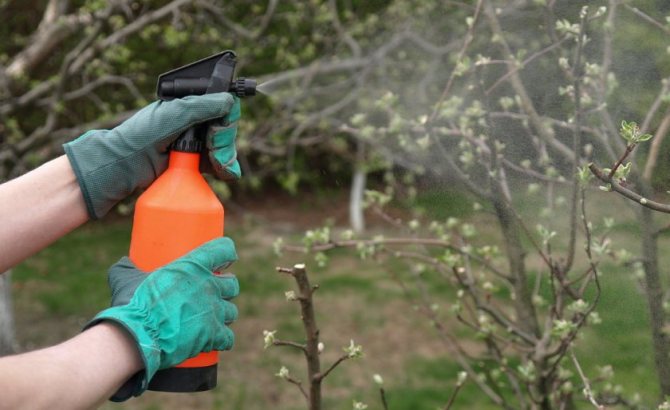

Copper sulfate, "Kuprozan", "Ftalan" are used for such treatments. If the cherry has reached the fruiting age, and there are still no fruits, you first need to determine the reason for the lack of fruiting and solve this problem. Many mistakes in the care of this fruit tree can be corrected.
Diseases
Diseases provoking the problem:
- coccomycosis;
- moniliosis.
The first ailment can be identified by brown spots on the outside and back of the leaves. Often the spots are accompanied by a pink-scarlet bloom. With a progressive disease, photosynthesis is disrupted, leaves fall, and the tree refuses to bear fruit. Also, coccomycosis adversely affects winter hardiness and leads to tree loss, even in an average severity winter.
The fight against this ailment involves spraying trees with copper-containing preparations (for example, 1-2 percent Bordeaux liquid), whitewashing the trunks and the first skeletal branches in late autumn.Fungicides are applicable, for example, "Skora".
Monilial burn refers to a fungal disease that usually affects flowering trees and in high humidity conditions. The fungus penetrates the ovaries at the stage of their formation, which further leads to their massive shedding. In summer, the pathogen infects unripe fruits, causing them to rot. Signs of illness:
- dried leaves;
- "Burnt" shoots;
- gray-brown spots.
In this case, the tree is freed from all affected shoots and is treated with copper-containing preparations.


How to cure a tree
Reasons why cherries do not bear fruit or have a poor harvest:
- fungal infections: moniliosis, coccomycosis;
- shaded growing area;
- acidic soil, lack of fertilization;
- you need a pollinator variety;
- incorrect pruning;
- freezing of the kidneys.
Solving disease problems
If all the rules of care are followed, but its branches dry up, the inflorescences fall off: the reason lies in the presence of diseases:
Moniliosis is a type of fungal infection that affects flowers, leaves and shoots. The disease manifests itself in the form of burns on leaf plates, such a tree blooms poorly, half of the ovaries dries out and falls off. During the period of illness, the bark may crack, accompanied by the release of gum. If the disease has attacked the cherry before the age of 7, there is a high chance of losing the tree.
What to do when dealing with moniliosis:
- eliminate all damaged areas: leaves, branches, flowers;
- treat the places of cuts and damage to the bark with a solution of copper sulfate 1%, in a proportion of 200 g per 10 liters of water;
- cover the treated wounds with sorrel, doing the procedure three times with an interval of 15 minutes;
- anoint with wood ash.
Coccomycosis is a disease of fruit trees related to the genus of fungal infections. It manifests itself in the form of small specks on the leaves and a pinkish bloom on the back.
Spores of the fungus spread to the entire plant, because of them more than half of the berries can be lost. Characterized by the manifestation of black spots and gray growths on the fruits, which leads to their wilting and dropping. It is a common reason why cherries do not bear fruit.
What to do when fighting Coccomycosis:
- in order to prevent early spring, sprayed with a solution of copper 300 g per 10 liters of water;
- sanitary pruning is required every year, which will reduce the risk of disease;
- planting a variety that is immune to coccomycosis;
- loosening the soil around the trunk circle;
- collection and destruction of fallen leaves, dry branches, fruits: it is recommended to do the procedure throughout the entire period of ripening of berries in order to prevent the spores of the fungus from entering the soil;
- after swelling of the kidneys, treat with Horus in a proportion of 2 g per 10 liters.
Soil acidity
Cherry begins to ache, does not bring a lot of harvest, development stands still if the acidity of the soil is increased. To make sure that the assumptions are correct, use the acidity measurement method:
- using a pH meter;
- litmus paper.
It is enough to buy a litmus in a pharmacy and conduct an experiment. Collect soil from different places on the site, wrap each sample in a thick cloth and place in containers with distilled water, let it brew for 5 minutes. Next, dip a piece of litmus and check the result against the attached acidity scale.
According to the rules, the elimination of soil acidity should take place even before the seedling is planted, then there will be no problems related to the harvest. Under the influence of weather conditions, it is possible to change the pH of the soil after planting.
To change the acidic soil to neutral, it must be calcified. For this, dolomite flour is used. It is simple to prepare it:
- Pour 100 kg of lime on a flat soil surface;
- pour 3-4 liters of water, wait 20 minutes for the reaction;
- remove the top layer (fluff) and repeat the procedure.
The resulting fluff is abundantly mulched around the trunk circle or the area on which the seedling will grow. How much dolomite flour is required:
- on acidic soil 0.5 kg per 1 m;
- medium acidity of 0.4 kg;
- a slightly acidic environment requires 0.3 kg of fluff.
Lack of feeding
Cherries grow poorly and bear fruit due to poor care, which consists in a lack of feeding and watering. Although the culture is drought-resistant, the lack of sufficient moisture contributes to the degeneration of the fruits, deterioration of their taste and external qualities.
To obtain a stable harvest, the tree should be properly watered.
- Watering should be carried out in dry weather in the morning or evening to avoid strong evaporation and leaf burns.
- After applying the liquid, the soil around the trunk is mulched with sawdust, which retains the necessary moisture and provides oxygen access. The procedure has a positive effect on the taste of the berries, they become sweeter and juicier.
- Additional watering is carried out during the period of intensive development of the seedling and during the ripening of the fruit.
If the cherry fruit does not set, the cause may be a lack of minerals. The tree, without receiving additional fertilizing, puts all its strength into growth and the fight against infections, it does not have enough strength to bear fruit.
To fertilize cherries, liquid mineral dressings are used in small dosages.
The spring period is the time for nitrogen fertilizers, the main thing is not to overdo it with the dose, otherwise there is a risk of root system burns. 20 g of urea, diluted in 10 liters of water and introduced into the soil at the trunk and the entire projection of the crown.
In the autumn, the soil is loosened together with superphosphate fertilizer in the amount of 30 g per 1 m, wood ash is also used in the amount of 200 g. Fertilization with compost is carried out in the fall, mulching the soil in the amount of 2 kg of fertilizer per 1 m.
Pruning
Incorrect pruning, carried out at the wrong time, badly affects the yield. Untreated tools can infect and be the reason why cherries do not form flower ovaries or give birth to barren flowers.
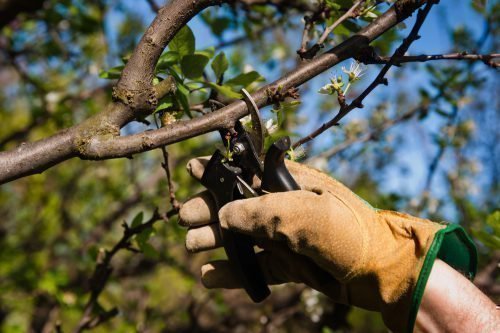

It is important to follow the rules for annual pruning.
- The first pruning is done the next summer after disembarkation. The top of the main shoot is shortened by 20 cm, all branches are cut off at a distance of 45 cm in height from the soil, 5 shoots are left on the trunk, forming a tree.
- In the second year of cherry growth, you should select up to 6 shoots and compare them with the main one. Shorten skeletal branches so that they are 25 cm shorter than the central shoot, other branches are cut by 10 cm or cut off completely.
- In the third year of growth, the branches are shortened by 10-15 cm if their length is more than 60 cm. Small branches thickening the crown are cut off with a saw.
- Fourth year: remove all improperly growing shoots that are located inland. Compare all shoots in the center, they should be cut by 15 cm.
- In the fifth year of life, pruning is carried out, eliminating excess thickening, by the end of the year a tree with 10 skeletal branches should be formed.
It's all about the weather
If the spring frosts return, it rains, or, conversely, the weather is dry, the gardener may also be left without a crop.
If the trees have bloomed, and the forecast promises freezing temperatures at night, you need to throw covering material on them. Spraying with "Epin" will help prepare plants for unfavorable environmental factors. It is important to carry out processing before the start of frost.
With high humidity or drought, initiation often helps, stimulating the formation of ovaries.
With frequent lingering rains, frequent loosening of the trunks is useful. If this work is neglected, high humidity will lead to root rot.
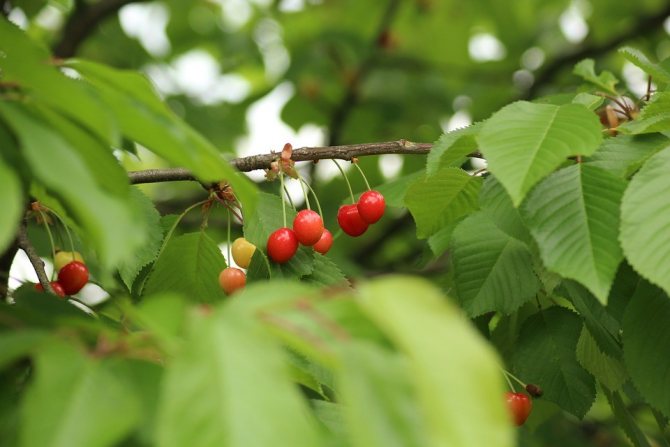

Existing varieties
There are so many different varieties. All of them differ in taste, fruits, ripening speed.
- Early varieties ripen in June. This group includes: Kent, English, Griot Ligel, etc.
- Medium - bear fruit from July to August.The main advantage is that they have a very high yield: Volochaevka, Griot Melitopolsky, Griot Moskovsky.
- Late varieties are special varieties whose fruits ripen in September. It's late enough, but the result is worth it. When almost all fruit trees are no longer bearing fruit, you can enjoy fresh berries, stock up on them for the already approaching winter. Delicious, fleshy, large fruits are obtained: Robin, Generous, Erudite, Toy, etc.
Lack of food
On barren land, cherries bloom, but do not want to form fruit, or give a small increase, but refuse to even bloom.
The scheme for feeding cherries is as follows: in spring, with wet soil, trees are fed with nitroammophos, after blossoming of trees - with superphosphate, fruiting - with wood ash. At the same time, young trees, provided that the planting pit has been properly prepared, can not be fed.
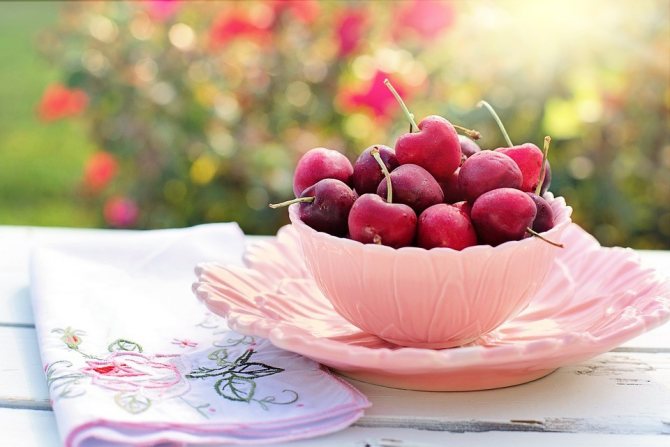

Reason # 1. Unsuitable agro-climatic conditions
Sometimes from gardeners you can hear the words: "Our places are not cherry blossoms." Indeed, cherry is a very demanding crop for growing conditions and may refuse to bear fruit if the plot does not correspond to them.
For the successful fruiting of cherries, you must:
- a lot of sunlight;
- warm places, protected from cold wind and draft;
- well-drained, sandy loam soil;
- neutral soil pH values.
If the cherry does not bear fruit, you must first check how the place of its growth meets these conditions.
Tip # 1. Cherry is a thermophilic culture, and for its successful cultivation in most regions of Russia, it is necessary to purchase winter-hardy varieties.
Incorrect cropping
Quite rarely, but still, cherries may refuse to bloom due to an overly thickened crown. If the tree has never been pruned since planting, years later, the crown can thicken to such an extent that the cherry will refuse to form fruit.
To prevent this from happening, as it grows, a tree with no more than 15 skeletal branches is formed from it.
Further in the spring, usually in March, sanitary pruning is carried out, which involves the removal of dry, frozen, diseased, broken and growing shoots inside the crown.
Crown rejuvenation is based on reducing the number of branches, shortening the remaining ones by half or by a third. Annual increments remain intact. Important: Anti-aging pruning is a step-by-step exercise.
What you need to do to force and increase fruiting
To get a high yield of cherries, it is necessary to organize proper care for it, and this, first of all, watering and feeding.
During the entire growing season, the cherry orchard must be watered at least three times:
- in the last days of May, when shoots are actively growing;
- 14 days before harvest;
- right after picking the cherries.
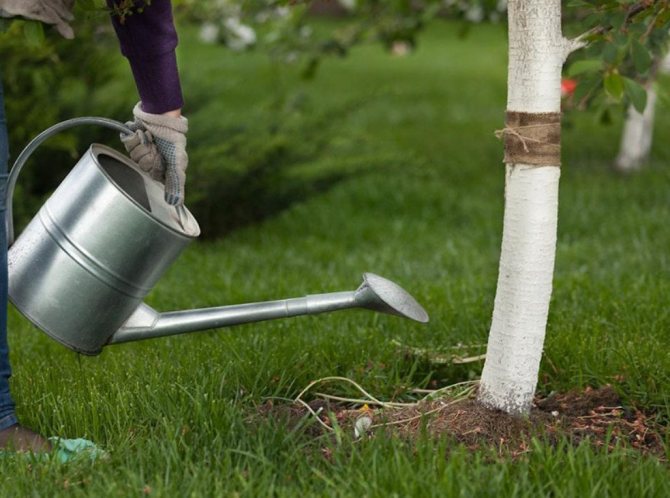

Watering should be abundant. Pour 60 liters under each fruit tree. To retain moisture, you can additionally mulch the soil around the tree. In the spring, be sure to loosen the soil around the close area in order to improve the flow of water and air to the root system.
If a tree experiences waterlogging due to frequent rains, then the soil under it must be loosened more often in order to increase the evaporation of moisture. In the fall, cherries are not moistened due to the likelihood of frost. The key to a good harvest of cherries is top dressing - they begin to be produced 3-4 years after the seedling is planted.
Important! If groundwater is close, then cherries can be planted on mounds about 1 m high, that is, they do not dig a hole. It is advisable to drain groundwater and water that accumulates.
Gardeners recommend doing the following:
- The first feeding is carried out when the snow has not completely melted yet. For this purpose, bring nitroammofosku (you can azofosku) at the rate of 45-50 g per 1 m².
- The second feeding is carried out during flowering. First, potash-nitrogen fertilizers are applied in the area around the cherry on the basis that 18 g of each element is consumed per 1 m². Then, after that, a layer of organic matter is distributed around the trunk, at least 3 cm thick. Compost, as well as manure and humus, are well suited as an organic fertilizer.
- The third application of nutrients is carried out after flowering at the stage of fruit formation. Phosphorus-potassium fertilizers are applied to the soil. Such feeding contributes to the appearance of more buds for fruiting the next year. In addition, the fruits will be larger.
Video: fertilizing cherries
Foliar dressing can also be done. It is carried out 10 days after the beginning of flowering. The spray solution is prepared as follows - 1 table. a spoonful of urea per 10 liters. After 14 days, it is advisable to repeat this treatment. This procedure will promote abundant fruit production. Gardeners also recommend fertilizing the soil around the cherry trunk with crushed egg shells and chalk.
We recommend that you familiarize yourself with the features of grafting cherries in the spring.
If the cause of crop failures is the high acidity of the soil, then it should be limed. With excessive accumulation of water, it will be necessary to make drainage grooves and pits. The thickened crown is pruned. If a tree shading a cherry tree grows nearby, then it must be pruned. When the first signs of disease are detected, all the affected areas are cut off and fungicidal preparations containing copper are used. Against insect pests, treatments with copper oxychloride, "Karbofos", "Benzophosphate" are carried out.
conclusions
Now you know how much time and effort it will take to harvest the first crop from your tree. By taking care of your cherry trees the right way, you can speed up the ripening times and get rich harvests from your own garden.
There are many nuances when choosing a variety and planting fruit trees in your own garden. Young seedlings gradually take root, grow and soon begin to bloom and bear fruit. Unfortunately, it happens that several years pass, and the tree does not bloom, although outwardly it seems healthy. Let's find out in what year after planting the cherry begins to bear fruit and what reasons can interfere with flowering.
Varieties
One of the criteria that is used when choosing a variety is the time of fruiting.
Early, medium and late ripening varieties are classified.
- Early: English early, Kent, Griot Ligel, Memory of Yenikeev, etc. The fruits begin to ripen at the end of June.
- Medium: Melitopol dessert, Griot Melitopolsky, Volochaevka, Griot Moskovsky. These varieties bear fruit in late July - early August and give a high-quality harvest.
- Late: Generous, Rusinka, Robin, Toy, Erudite. Ripen in late August - early September. They have tasty and large fruits.
The benefits of cherry berries
Including cherries in your diet is a must. This is due to the fact that they contain trace elements:
- organic acids (salicylic, malic, succinic);
- vitamins (A, C, B, PP);
- iron, phosphorus, magnesium, calcium;
- fructose;
- pectin.
They improve immunity, increase the resistance of the nervous system to external influences, prevent diseases of the gastrointestinal tract, asthma. This is not only a delicious berry, but also an excellent support for the body. Its beneficial properties should not be ignored. Grow your own tree and enjoy natural fruits. They can be used in culinary products: jam, preserves, cakes, pies, dumplings, jellies, compote, ice cream and many other goodies.


Frozen kidneys
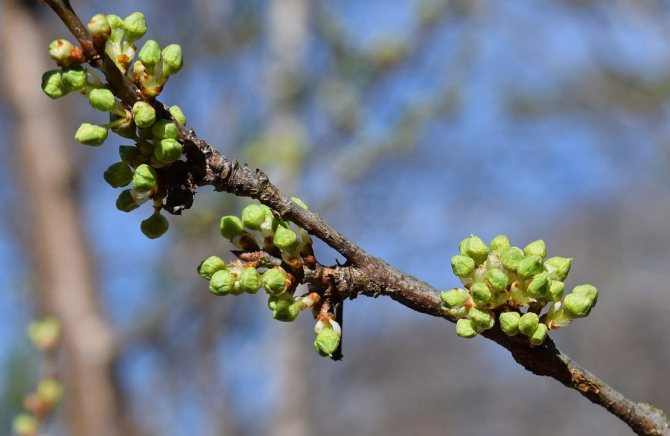

Even small seasonal frosts are enough to freeze the buds.Spring and autumn weather changes are dangerous, therefore, when the air temperature drops below +0 C, the plants must be covered with spunbond or other material. After the onset of autumn frosts, the shrub is no longer watered.
Compositions Novosil, Epinom-Extra increase the resistance of cherries to frost. Spray according to instructions.
Basic information about cherries
The most common representative of the species is ordinary cherry. Does not grow in the wild. It has been cultivated for more than one century. Breeders tirelessly breed all new varieties, for example, Bessey, Vladimirsky cherry, dessert variety Iput, Molodezhny, Morozov, Sania, Turgenevka, etc.
According to its individual characteristics and structure, it is divided into two types: tree and bushy.
The bush form is characterized by a spherical crown, the branches are lowered, shoots are formed abundantly, the fruits are almost black in color. Subject to all the rules of agricultural technology and in optimal climatic conditions, it actively bears fruit for 10-18 years. The root system of a bush-shaped tree grows around 6-7 meters, does not lie very deep. This form has high rates of frost resistance, in contrast to the tree.
The fruit tree bears fruit with sweet and sour berries. They have a universal purpose: they are eaten fresh, added to baked goods, prepared compotes / jelly / liqueurs and much more, as well as dried and frozen.
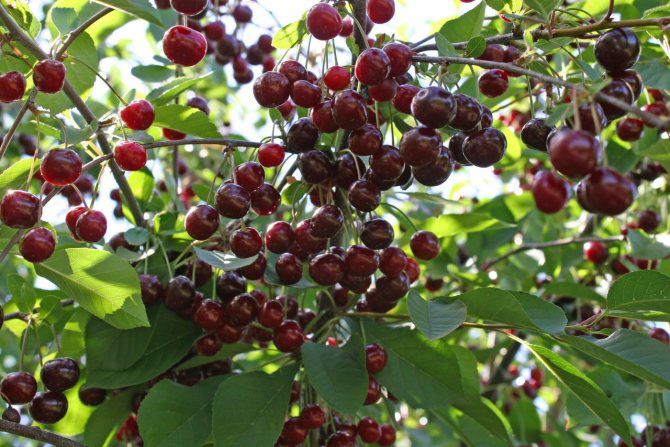

How many times does a cherry bear fruit
The fruit contains a high concentration of tannins, vitamins A, B, C and PP, organic acids, pectins, macro- and microelements, fructose, ash and nitrogenous compounds are present. Due to its chemical composition, the fruits are widely used in traditional medicine. The composition contains pectins that cleanse the body of toxic substances.
Important! When cooking cherry jam, seeds should be removed from berries, since they contain amygdalin. As a result of heat treatment, organic bonds disintegrate and poisonous substances are formed.
Useful properties of cherries for the body:
- Stimulates an increase in hemoglobin levels, lowers blood pressure and strengthens the capillary walls.
- An effective preventive measure against angina attacks, heart attacks, atherosclerosis, strokes and thrombosis.
- It is used to treat gout and arthritis, as it reduces the concentration of uric acid in the body.
- It contains copper, which is effective in the fight against mental illness.
- Fights the causative agents of dysentery, and is also active against streptococci and staphylococci.
- The composition includes a high concentration of pectins, so the berries effectively cope with constipation, remove toxic substances from the body.
- It is used in the form of expectorant and antipyretic drugs.
From the pulp, you can make masks that nourish and cleanse the skin well, tighten the pores.
Bad neighborhood
The culture does not tolerate conifers, apple trees and honeysuckle next to it. Of flowers, pansies, lilies, daffodils, tulips, irises will be bad neighbors. But grapes, cucumbers, beets, salads, pumpkin and onions can be planted right next to the trunk or cherry bush.
Summer rules for cherry care to prevent berries from falling off
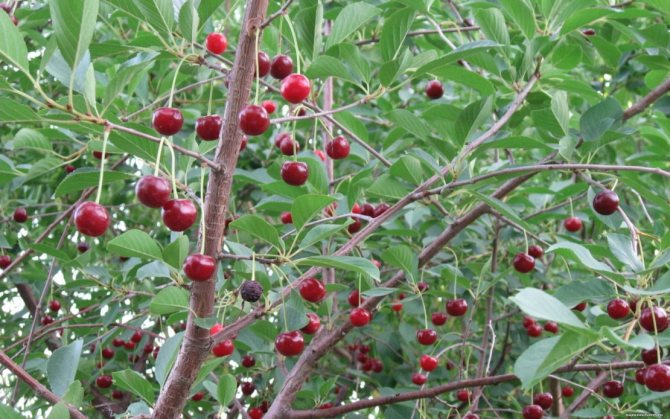

Trunk circles are sown with hazel grouse, turnips, peas or marigolds. Plants have a beneficial effect on berries and are natural enemies of the fruit fly.

